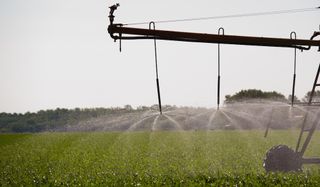Water Woes: Vast US Aquifer Is Being Tapped Out

Nearly 70 percent of the groundwater stored in parts of the United States' High Plains Aquifer — a vast underground reservoir that stretches through eight states, from South Dakota to Texas, and supplies 30 percent of the nation's irrigated groundwater — could be used up within 50 years, unless current water use is reduced, a new study finds.
Researchers from Kansas State University in Manhattan, Kan., conducted a four-year study of a portion of the High Plains Aquifer, called the Ogallala Aquifer, which provides the most agriculturally important irrigation in the state of Kansas, and is a key source of drinking water for the region.
If current irrigation trends continue unabated, 69 percent of the available groundwater will be drained in the next five decades, the researchers said in a study published online today (Aug. 26) in the journal Proceedings of the National Academy of Sciences.
"I think it's generally understood that the groundwater levels are going down and that at some point in the future groundwater pumping rates are going to have to decrease," study lead author David Steward, a professor of civil engineering at Kansas State University, said in a statement. "However, there are lots of questions about how long the water will last, how long the aquifer will take to refill and what society can do." [Earth Checkup: 10 Health Status Signs]
Taking water measurements
Steward and his colleagues collected data on past and present groundwater levels in the Ogallala Aquifer, and developed statistical models to project various scenarios of water depletion over the next 100 years.
Using current trends in water usage as a guide, the researchers estimate that 3 percent of the aquifer's water was used up by 1960; 30 percent of the aquifer's water was drained by 2010; and a whopping 69 percent of the reservoir will likely be tapped by 2060. It would take an average of 500 to 1,300 years to completely refill the High Plains Aquifer, Steward added.
Sign up for the Live Science daily newsletter now
Get the world’s most fascinating discoveries delivered straight to your inbox.
But, if reducing water use becomes an immediate priority, it may be possible to make use of the aquifer's resources and increase net agricultural production through the year 2110, the researchers said.
"The main idea is that if we're able to save water today, it will result in a substantial increase in the number of years that we will have irrigated agriculture in Kansas," Steward said.
A lot of variables
Yet, making projections about water security is challenging, because there are a number of factors to consider, and even though the High Plains Aquifer touches eight different states, the effects can be highly localized, said Bridget Scanlon, a senior research scientist and leader of the Sustainable Water Resources Program at the University of Texas at Austin, who was not involved with the new study.

"We know the aquifer is being depleted, but trying to project long-term is very difficult, because there are climate issues and social aspects that have to be included," Scanlon told LiveScience. "Projections are so difficult because I think we're clueless about a lot of things, like extreme weather events."
Scanlon pointed out that the new study does not consider the impact of extreme weather, such as droughts or floods. In 2011, Texas experienced a devastating drought that cost the state some $8 billion in economic losses, according to a report by Susan Combs, Texas Comptroller of Public Accounts. NASA satellites that studied the parched land determined that the drought depleted the region's aquifers to low levels that had rarely been seen since this type of mapping began more than 60 years ago. [Dried Up: Photos Reveal Devastating Texas Drought]
Finding a solution to the groundwater depletion problem is also tricky without unfairly targeting the farmers, Scanlon said.
"Farmers are trying to make a living, and they're responding to economics," she explained. "Asking them to drastically reduce water might be like asking me to retire now because there are so many unemployed people."
Too many unknowns?
Steward and his colleagues anticipate future technologies will help farmers irrigate their land more efficiently. "Water use efficiencies have increased by about 2 percent a year in Kansas, which means that every year we're growing about 2 percent more crop for each unit of water," Steward said. "That's happening because of increased irrigation technology, crop genetics and management strategies."
But in some areas of the country's plains, the properties of the groundwater and soil largely dictate the irrigation techniques, Scanlon said. In parts of Texas and Kansas, the groundwater is brinier, which means if some farmers employ more efficient irrigation techniques, they will also be pumping up salty deposits that are not adequately washed away by rainfall.
"This is a very nice study, but we really need to address droughts and socioeconomic issues, and other approaches to figure out the problem, beyond the technical," Scanlon said. "If we don't know what we're doing, are we just rearranging the deck chairs on the Titanic?"
Follow Denise Chow on Twitter @denisechow. Follow LiveScience @livescience, Facebook & Google+. Original article on LiveScience.

Denise Chow was the assistant managing editor at Live Science before moving to NBC News as a science reporter, where she focuses on general science and climate change. Before joining the Live Science team in 2013, she spent two years as a staff writer for Space.com, writing about rocket launches and covering NASA's final three space shuttle missions. A Canadian transplant, Denise has a bachelor's degree from the University of Toronto, and a master's degree in journalism from New York University.
